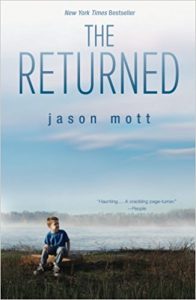The Returned, by Jason Mott
The Returned
By Jason Mott
Harlequin MIRA
Three Stars
Reviewed by Jessica Gribble
What if dead people came back to life? In Jason Mott’s novel The Returned, many random people do. They pop up all over the world, disoriented, looking for the people they used to know. Of course, they don’t always speak the right language, so sometimes it’s difficult to get back to the places they’re trying to find. They’re the same age they were when they died, which means they might suddenly be in a wildly different position relative to the people they knew—assuming they find each other.
The main characters of the novel are an elderly couple named Harold and Lucille. We learn very early that their son Jacob died on his eighth birthday; they didn’t have other children. When a Returned Jacob shows up on the front porch and timidly tells one of the corny jokes he used to share with Harold, everything changes, for them and for their town, Arcadia. People are Returning all over the world. Naturally, the government gets involved. At first, it’s fairly innocuous. Returned people are processed, kept track of. The pastor, an important personage in the small town, tries to steer the conversation; he rejects angry ideas that the Returned should be rounded up. He suggests that God loves everyone. But there’s still an undercurrent of tension. The characters have to choose sides: are the Returned real people? Or do only the True Living have rights?
Eventually, the bureaucracy takes over Arcadia. “It had begun small, as most large things do, with just one government-issue Crown Victoria containing only one government man and a pair of too-young soldiers and a cell phone.” But soon “the Bureau had developed a plan for Arcadia. The same isolation that had kept the town’s economy stifled for all the years of its existence was exactly what the Bureau was looking for.” Arcadia becomes an internment camp. There are visiting hours. Jacob is interred, so Harold goes with him. Lucille respects visiting hours—until she doesn’t anymore. The first government agent to arrive, the man in charge, turns out to be intimately connected to the Returned. The pastor has a secret. Past town events no one wants to remember are revisited. Several angry men take matters into their own hands—but what are they truly angry about? The situation slips slowly but inevitably into violence.
As a thought puzzle, the book is interesting. The characters are engaging and likeable. Mott invests even the “bad guys” with humanity. In their shoes, the reader wonders, wouldn’t I do the same things? However, the story is a bit pat. The people and scenes are caricatures; no one does—or even feels—anything unexpected. The writing is serviceable; it carries the story, but does little more, though every now and again Mott comes up with a line that feels particularly true: “His eyes began to well up. And as any man does when faced with the raw terror of emotion, he surrendered to his wife and buried his thoughts below the anvil of his heart.”
In the end, it feels too planned, like Mott drew a chart of events and filled in the characters. If people came back to life, some would find each other again and fulfill their true romance: Lewis and Suzanne. If people came back to life, someone would choose to do the right thing after an internal struggle: Lucille. If people came back to life, someone would lead the mob against them: Fred Green.
Readers will enjoy this book if its thought puzzle intrigues them and they enjoy an easy-to-read, generally moving novel with some moral uncertainties.
